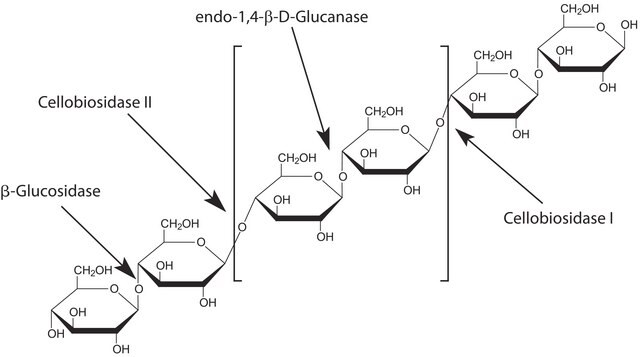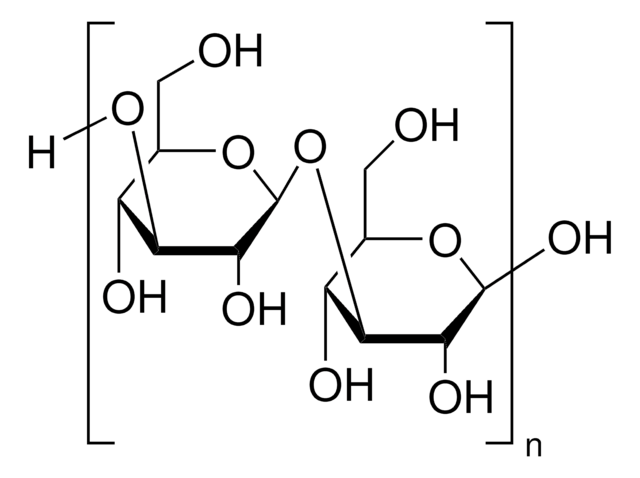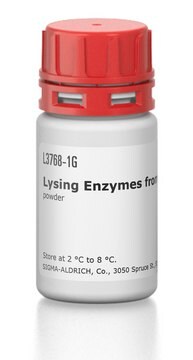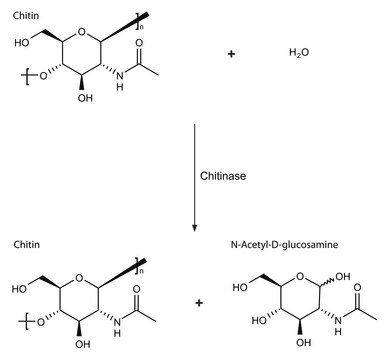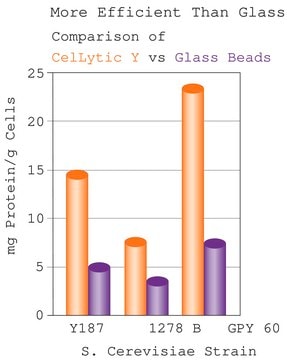67138
β-(1→3)-D-Glucanase from Helix pomatia
≥0.2 U/mg
Iniciar sesiónpara Ver la Fijación de precios por contrato y de la organización
About This Item
Productos recomendados
biological source
Helix pomatia
form
powder
specific activity
≥0.2 U/mg
storage temp.
−20°C
¿Está buscando productos similares? Visita Guía de comparación de productos
Application
β-(1→3)-D-Glucanase from is used to digest β -1,3-glucan, which is a major component of cell walls. β-(1→3)-D-Glucanase from Helix pomatia has been used fto digest the cell walls of C. albicans .
Biochem/physiol Actions
Deletion of the C.albicans histidine kinase gene (CHK1) improves recognition by phagocytes through an increased exposure of cell wall b-1,3-glucans, which are readily digested by β-(1→3)-D-Glucanases .
Packaging
Bottomless glass bottle. Contents are inside inserted fused cone.
Unit Definition
One unit corresponds to the amount of enzyme which liberates 1 μmol of glucose from laminarin (Cat. No. 61340) per minute at pH 5.0 and 37 °C
signalword
Danger
hcodes
pcodes
Hazard Classifications
Resp. Sens. 1
Storage Class
11 - Combustible Solids
wgk_germany
WGK 1
flash_point_f
Not applicable
flash_point_c
Not applicable
Elija entre una de las versiones más recientes:
¿Ya tiene este producto?
Encuentre la documentación para los productos que ha comprado recientemente en la Biblioteca de documentos.
Los clientes también vieron
Yoichi Tanabe et al.
Biochimica et biophysica acta, 1814(12), 1713-1719 (2011-10-08)
An endo-1,3-β-glucanase was purified from Tunicase®, a crude enzyme preparation from Cellulosimicrobium cellulans DK-1, and determined to be a 383-residue protein (Ala1-Leu383), comprising a catalytic domain of the glycoside hydrolase family 16 and a C-terminal carbohydrate-binding module family 13. The
Enrico Cabib et al.
Eukaryotic cell, 11(4), 388-400 (2012-03-01)
Previous results suggested that the chitin ring present at the yeast mother-bud neck, which is linked specifically to the nonreducing ends of β(1-3)glucan, may help to suppress cell wall growth at the neck by competing with β(1-6)glucan and thereby with
Marián Mazáň et al.
The Biochemical journal, 438(2), 275-282 (2011-06-10)
BGTs [β-(1,3)-glucanosyltransglycosylases; EC 2.4.1.-] of the GH72 (family 72 of glycosylhydrolases) are GPI (glycosylphosphatidylinositol)-anchored proteins that play an important role in the biogenesis of fungal cell walls. They randomly cleave glycosidic linkages in β-(1,3)-glucan chains and ligate the polysaccharide portions
Nina Klippel et al.
Microbiology (Reading, England), 156(Pt 11), 3432-3444 (2010-08-07)
The pathogenic fungus Candida albicans is able to cover its most potent proinflammatory cell wall molecules, the β-glucans, underneath a dense mannan layer, so that the pathogen becomes partly invisible for immune cells such as phagocytes. As the C. albicans
Poonam Gautam et al.
Mycopathologia, 172(5), 331-346 (2011-07-15)
Artemisinin, an antimalarial drug, and its derivatives are reported to have antifungal activity against some fungi. We report its antifungal activity against Aspergillus fumigatus (A. fumigatus), a pathogenic filamentous fungus responsible for allergic and invasive aspergillosis in humans, and its
Nuestro equipo de científicos tiene experiencia en todas las áreas de investigación: Ciencias de la vida, Ciencia de los materiales, Síntesis química, Cromatografía, Analítica y muchas otras.
Póngase en contacto con el Servicio técnico